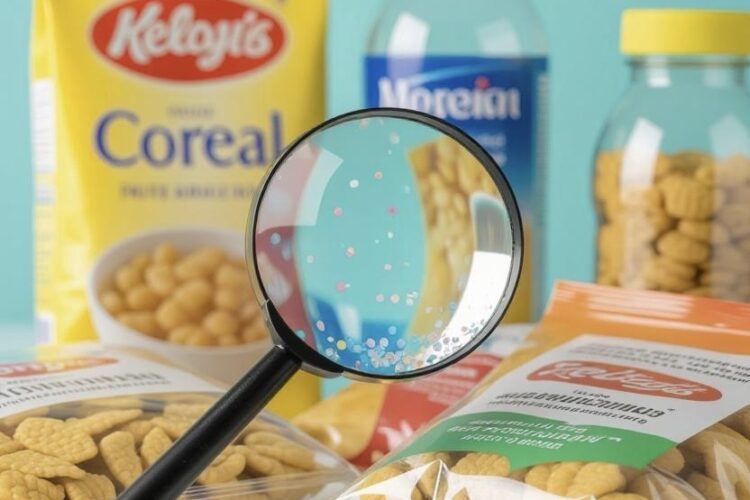Microplastics and nanoplastics from plastic packaging contaminate packaged foods, especially processed items and beverages, posing health risks through ingestion. These tiny particles, formed by migration, leaching, or environmental pollution, carry toxic additives like phthalates and BPA, linked to inflammation, immune issues, infertility, and cancer risks. Advanced detection methods, such as FTIR and Raman spectroscopy, confirm their presence in foods. Bioaccumulation in tissues like the gut and arteries raises concerns about long-term toxicity. Regulatory efforts aim to limit plastic additives, while biodegradable polymers and edible bioplastics offer sustainable packaging solutions. To reduce exposure, choose unpackaged produce, use glass containers, and support stricter policies. Staying proactive is key to addressing this hidden health threat.
Long Version
Microplastics in Packaged Foods: Unseen Contaminants and Their Impact on Human Health
Microplastics and nanoplastics have emerged as pervasive pollutants in our modern food systems, infiltrating everything from processed foods to beverages through plastic packaging. These tiny particles, often resulting from environmental pollution and food contamination, pose significant health risks due to human exposure via ingestion and accumulation in the body. As global awareness grows, understanding their sources, detection, toxicity, and potential solutions is crucial for food safety and public health.
How Microplastics Enter Our Food Supply
Plastic packaging is a primary culprit in introducing microplastics into packaged foods. Through processes like migration and leaching, particles transfer from packaging materials into food contents, especially under mechanical stress or high-temperature effects, such as during heating or storage. For instance, when consumers unwrap plastic-sealed items, microscopic bits slough off directly into the food, exacerbating contamination. Processed foods and beverages are particularly vulnerable, with studies showing that 89% of packaged items contain microplastics compared to just 12% in fresh produce. Nanoplastics, even smaller and more insidious, can degrade from heat-sensitive packaging during food preparation, releasing into dairy products and other items. Environmental pollution further compounds this, as microplastics from broader ecotoxicology issues—like ocean debris—enter the food chain, bioaccumulating in seafood such as sardines. Fiber-type particles often stem from textiles and atmospheric deposition, while fragment-type particles arise from the breakdown of larger plastics under stress.
Detecting Microplastics in Food: Advanced Analytical Methods
Identifying these contaminants requires sophisticated analytical methods. FTIR spectroscopy and Raman spectroscopy are gold standards for detection, offering high sensitivity and accuracy in analyzing microplastics in food systems. FTIR excels at classifying particle composition by measuring infrared absorption, while Raman spectroscopy provides detailed molecular fingerprints, often combined with deep learning for near-perfect accuracy in food samples. These techniques have revealed widespread presence in beverages and processed items, with recent reviews evaluating over 56 studies on Raman’s application in food contamination assessments. Emerging tools, including artificial intelligence-driven detection, enhance efficiency, overcoming limitations of traditional separation methods in marine ecosystems and packaged goods. For comprehensive analysis, extraction protocols isolate particles before spectroscopic identification, ensuring reliable data on contamination levels.
Health Risks: From Ingestion to Long-Term Toxicity
Human exposure to microplastics primarily occurs through ingestion, with particles accumulating in tissues like the gastrointestinal tract, carotid artery tissues, and even the brain. Bioaccumulation leads to toxicity, as these particles act as carriers for harmful additives such as phthalates, Bisphenol A (BPA), and monomers, which leach into the body. Chronic biological effects include oxidative stress, inflammation, and cytotoxicity, disrupting the immune response and potentially causing gastrointestinal disorders. Respiratory problems arise from inhaled particles, with nano-sized plastics damaging mitochondria in lung cells. More alarmingly, studies link microplastics to carcinogenic potential, infertility, and chromosomal alterations, with BPA specifically tied to endocrine disruption, breast and prostate cancers, and metabolic disorders. In reproductive systems, microplastics have been found in testes, correlating with declining fertility rates—projections suggest severe impacts by 2050 if unchecked. Ecotoxicology research highlights similar effects in animals, underscoring the broader environmental and health parallels. While sharp particles cause physical irritation, chemical additives amplify risks, potentially contributing to neurotoxicity and immune dysfunction. Recent 2025 data indicates rising concentrations in human tissues, with in vitro and in vivo experiments confirming accumulation in intestines and associated health hazards.
Regulatory Actions and Food Safety Measures
Regulatory action on microplastics remains evolving, with agencies like the FDA stating that current levels in foods do not yet demonstrate a clear risk to human health, though ongoing monitoring could lead to interventions if evidence mounts. International efforts focus on environmental pollution reduction to curb bioaccumulation in food chains, emphasizing the need for standardized food safety protocols. Studies advocate for stricter limits on plastic additives, given their role in toxicity, and call for integrated science to assess ecotoxicology impacts. In regions like the EU, bans on certain phthalates in food contact materials aim to mitigate migration, but global inconsistencies highlight the urgency for unified policies. Public health advisories increasingly recommend minimizing exposure, such as avoiding heavily packaged processed foods.
Pathways to Mitigation: Alternatives and Practical Steps
To combat this issue, alternatives like biodegradable polymers and edible bioplastics offer promising solutions. Derived from renewable sources such as cornstarch, sugarcane, or seaweed, these materials reduce environmental pollution and minimize microplastic shedding in food packaging. Edible bioplastics, including those from algae, provide plastic-free options for foodservice, degrading naturally without contributing to toxicity. Other innovations involve compostable paper, biodegradable films, and natural coatings, revolutionizing sustainable packaging while maintaining food safety. Individuals can reduce exposure by shopping for unpackaged produce, using HEPA filters to curb inhalation, and opting for glass or cloth alternatives over plastic. Collective action, including policy advocacy, is essential to transition away from conventional plastics.
In summary, microplastics in packaged foods represent a multifaceted threat, from contamination pathways to profound health risks. By leveraging advanced detection, enforcing regulatory action, and adopting sustainable alternatives, we can safeguard human health and mitigate this invisible crisis. Staying informed and proactive is key to fostering a healthier future.
Hashtags For Social Media
#Microplastics #FoodSafety #PlasticPollution #HealthyEating #FoodContamination #EcoFriendly #SustainableLiving #HealthRisks #CleanEating #PlasticFree #EnvironmentalHealth #GreenLiving #ToxicFree #FoodPackaging #EcoAwareness #HealthyLiving #PollutionFree #Sustainability #HealthAndWellness #PlasticWaste #EcoConscious #SafeFood #EnvironmentalImpact #GreenChoices #NoMicroplastics #HealthAwareness #SustainableFood #EcoFriendlyPackaging #CleanFood #PlanetHealth
Related Questions, Words, Phrases
what are microplastics in packaged foods | how do microplastics get into food | health risks of microplastics in food | are microplastics in packaged foods dangerous | what foods contain microplastics | how to avoid microplastics in food | effects of microplastics on human health | nanoplastics in packaged foods | how does plastic packaging contaminate food | microplastics in processed foods | can microplastics in food cause cancer | how to detect microplastics in food | what is bioaccumulation of microplastics | microplastics in beverages | health impacts of phthalates in food | bpa in packaged foods risks | how do microplastics affect the immune system | microplastics in food safety concerns | biodegradable packaging to reduce microplastics | edible bioplastics for food safety | how does food packaging release microplastics | microplastics in dairy products | are microplastics in food regulated | environmental pollution and microplastics in food | microplastics in seafood health risks | analytical methods for microplastics in food | ftir spectroscopy for food contamination | raman spectroscopy in microplastic detection | microplastics and infertility concerns | chronic effects of microplastics in humans | how to reduce microplastic exposure from food | alternatives to plastic food packaging | microplastics in food and respiratory issues | toxicity of microplastics in packaged goods | regulatory actions on microplastics in food






